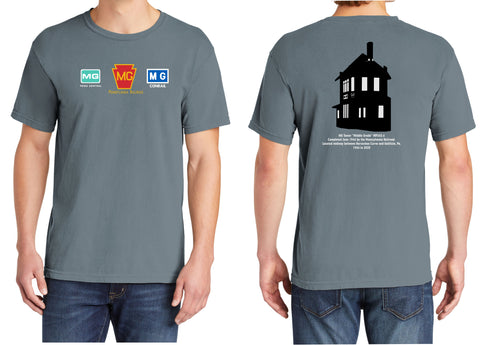
Penn Central G39B Faded Logo Hoodie
Penn Central G39B Faded Logo Hoodie
- 9-ounce, 50/50 cotton/poly fleece, Port & Company PC90H
- Printed Front Only
- Color Black
Iron ore travelled on the PRR from the inception of the steel industry. Until the 1940's, when the import of ore made any significant impact, the majority of the ore came from the Misabe range of Minnesota and was shipped via boat on the Great Lakes to eastern ports.
Until the arrival of cars specifically designed for the weight of iron ore -- the G38's and G39's circa 1960 -- almost any class of hopper came into use. H21a's were the most prevalent on the system, followed by GLa's.
Since iron ore was significantly heavier than coal, these hoppers could only manage one "scoop" of ore placed directly over each truck. This is why photos of ore in hopper cars make the cars look like they are largely empty. Filling the car or loading the center of longer cars would cause the car to buckle under the load! (An overhead view of an iron ore-loaded H21a appears on page 70 of Pennsy Steam Years, Volume I.)
Ken McCorry wrote "The H-21 class was the biggest on the PRR until the H-39 came along in 1960. Since the import ore business started in Phila in 1954 my educated guess would be H-21'a , GLa, H-31, H-35. The PRR knew the H-21 fleet was close to the end of it's economic life in the early 50's. They built or purchased the H-35 in 1956 as a possible replacement for the H-21 fleet. The H-36 and H-37 class were also built as a possible replacement. While most railroads would build a few cars for a test the PRR did it in a big way buying 1000-1500 of some of the pre H-39 classes. By the end of the 50's the 70 ton car was the norm and the H-39 became the replacement for the H-21. The ore business also showed the weakness of hopper doors keeping ore inside the car so thats one of the reasons the G-38's were built. When pellets became the norm the steam lance holes in the 38's would leak a steady stream of pellets along the right of way. The G-38 also cubed out with pellets before it weighed out therefore the G-39 class.
Ben Hom adds "Ken's guess is an excellent one, though the numbers of Class H31 (704 cars in 1953) and H35 (zero cars in 1954 - 2000 cars built in 1956) cars are far, far fewer than the other two classes (H21a 32,258, GLa 25,610 in 1955). Film shot by Clarence Weaver of the Shamokin Branch ore train in 1951-1952 show a predominance of Class H21a and GLa hoppers with a few foreign road hoppers appearing here and there (NYC, B&O, C&O). In fact, eastern roads that had ore traffic chose to use hoppers instead of purpose built ore cars until the 1960s, when they purchased specialized ore cars. In fact, the Bessemer and Lake Erie rated their offset triple hoppers (modeled accurately by the Ulrich offset triple in HO) at 90 tons, equipping their cars with heavy duty trucks with outside clasp brakes and using them in both coal and ore service. "
Dave Hopson notes "The Sept. 1962 of issue Trains magazine has a great article on PRR's ore traffic. It's required reading for the PRR fan."
Please allow 10 business days to ship,
*Image is a representation and may not be exact




